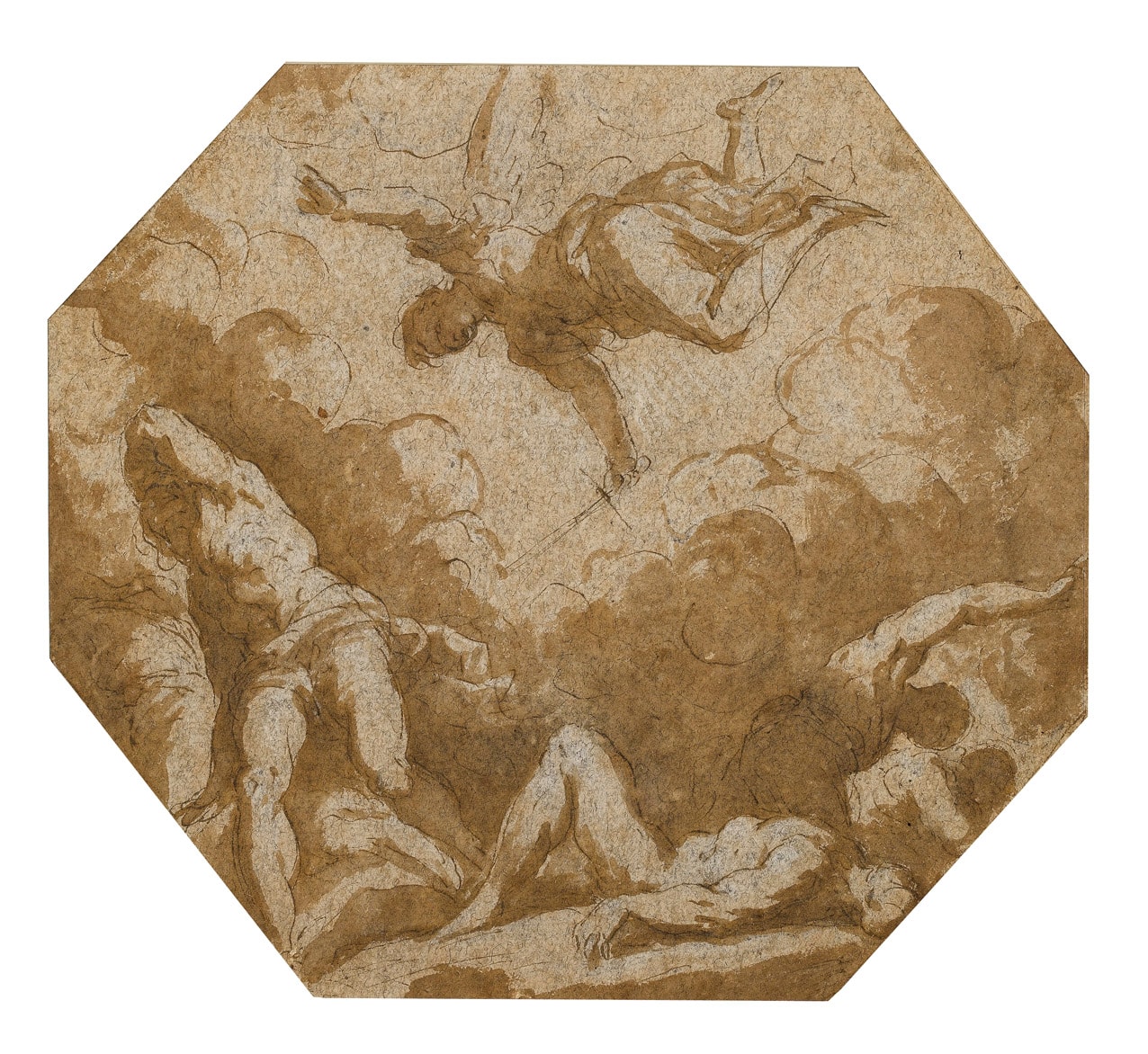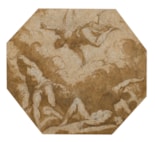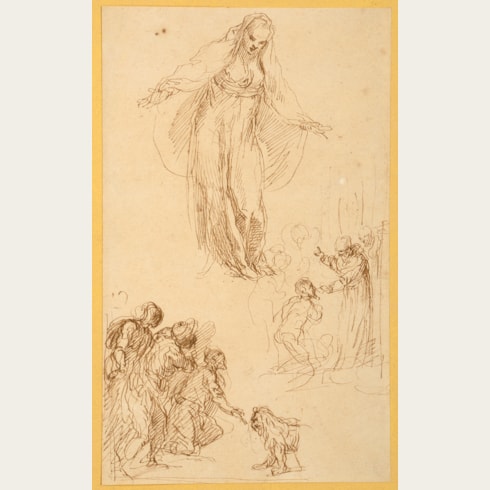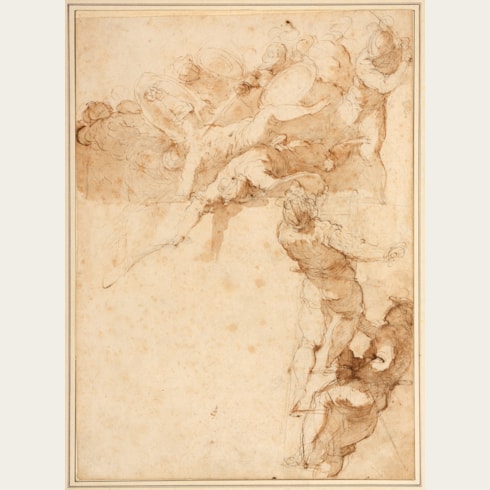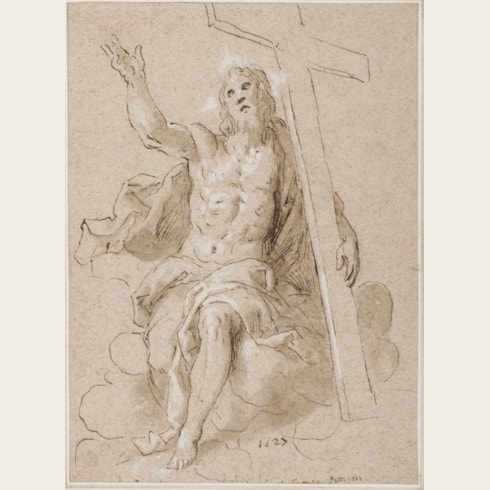Jacopo PALMA GIOVANE
(Venice 1548 - Venice 1628)
The Fall of the Rebel Angels
Sold
Pen and brown ink and brown wash, with touches of white heightening, over traces of an underdrawing in black chalk.
Made up at the corners and laid down.
Inscribed Palma at the lower right corner, and inscribed Mr de Menthon on the old backing board.
235 x 261 mm. (9 1/4 x 10 1/4 in.)
Made up at the corners and laid down.
Inscribed Palma at the lower right corner, and inscribed Mr de Menthon on the old backing board.
235 x 261 mm. (9 1/4 x 10 1/4 in.)
Although no related painting is known, the octagonal shape of this drawing would suggest that it may have been a preparatory study for a ceiling design. A similarly shaped drawing by Palma, formerly in the Michel Gaud collection in Saint Tropez, is a study for a ceiling painting of The Fall of Manna, painted between 1589 and 1590 for the church of the Gesuiti in Venice.
Palma Giovane treated the subject of The Fall of the Rebel Angels in at least two paintings, though both are different in composition and format from the present sheet. A painting in the Galleria Borghese in Rome is horizontal in format, while another painting of The Fall of the Rebel Angels in a private collection in Bergamo, though still dissimilar in composition, is closer in shape to the present sheet. A similar subject also occurs in a painting by Palma of the exterminating angels of the Apocalypse, part of a group of canvases making up an Apocalypse cycle painted for the Scuola Grande di San Giovanni Evangelista in Venice in 1581.
The present sheet bears the collector’s mark of the 18th century English collector Robert Udny (1722-1802), a West India merchant and collector of both paintings and drawings. In the first half of the 20th century the drawing entered the collection of the art dealer Marie Marignane who, with her brother Maurice, established the gallery M. Marignane & Sœur on the rue de Rennes in Paris, dealing in paintings, drawings and prints. Like her brother, Marie Marignane assembled a small private collection of Old Master drawings. Married to the painter Jacques Patissou, she retired to Nice in 1951.
Palma Giovane treated the subject of The Fall of the Rebel Angels in at least two paintings, though both are different in composition and format from the present sheet. A painting in the Galleria Borghese in Rome is horizontal in format, while another painting of The Fall of the Rebel Angels in a private collection in Bergamo, though still dissimilar in composition, is closer in shape to the present sheet. A similar subject also occurs in a painting by Palma of the exterminating angels of the Apocalypse, part of a group of canvases making up an Apocalypse cycle painted for the Scuola Grande di San Giovanni Evangelista in Venice in 1581.
The present sheet bears the collector’s mark of the 18th century English collector Robert Udny (1722-1802), a West India merchant and collector of both paintings and drawings. In the first half of the 20th century the drawing entered the collection of the art dealer Marie Marignane who, with her brother Maurice, established the gallery M. Marignane & Sœur on the rue de Rennes in Paris, dealing in paintings, drawings and prints. Like her brother, Marie Marignane assembled a small private collection of Old Master drawings. Married to the painter Jacques Patissou, she retired to Nice in 1951.
Known as Palma Giovane to distinguish him from his great-uncle, the painter Palma Vecchio, Jacopo Negretti studied in Pesaro and Urbino, where he gained the financial support of Guidobaldo II della Rovere, Duke of Urbino. The Duke sent him to complete his studies in Rome, where he spent several years, making copies after the frescoes of Michelangelo and Polidoro da Caravaggio. On his return to Venice in 1573 he may have worked in the studio of Titian, completing the Pietà left unfinished at the master’s death in 1576. To the influence of Titian was added that of Tintoretto and Veronese, which Palma combined with his experiences of Roman Mannerism to create what was to be his own distinctive, painterly style.
His first important commission came in 1578, when he provided three paintings for the ceiling of the Sala di Maggior Consiglio in the Palazzo Ducale in Venice. A prolific painter and draughtsman, Palma Giovane enjoyed a long career and received a large number of important commissions in Venice, particularly after the deaths of Tintoretto and Veronese. As well as providing altarpieces and ceiling paintings for numerous Venetian churches, Palma painted a cycle of pictures for the Ospedaletto dei Crociferi between 1583 and 1592 – a rare example in Venice of an entire cycle of paintings entrusted to one artist alone - and continued to contribute to the extensive redecoration of the various rooms of the Palazzo Ducale. He was also a talented portrait painter, although only a handful of examples are known today.
By the beginning of the 17th century Palma Giovane was firmly established as the leading painter in Venice, receiving commissions from patrons throughout Italy and beyond, such as the Emperor Rudolf II in Prague. He had a large and busy workshop, and more than six hundred paintings attributable to him or his studio are known.
Provenance
Robert Udny, London and Teddington, Middlesex (Lugt 2248)
His sale, London, T. Philipe and Scott, 4-10 May 1803, part of lot 305
Marie Marignane, Paris and Nice (Lugt 1848)
Comte [René?] de Menthon, Paris
By descent to a private collection, France.

